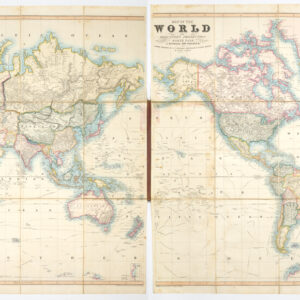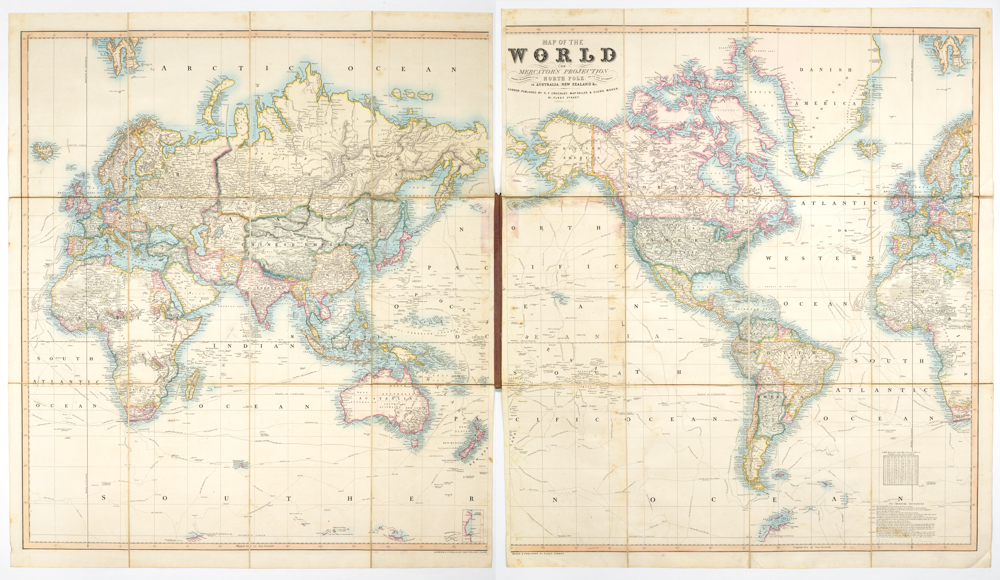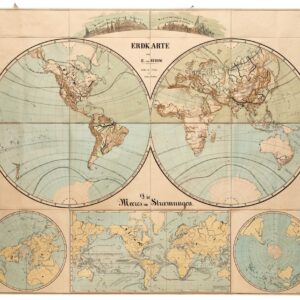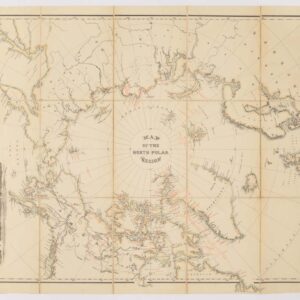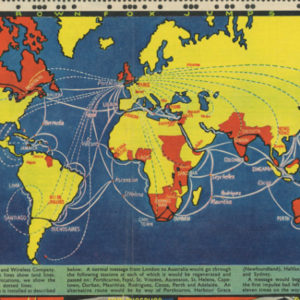A superb example of De Jode’s seminal polar projection of the world.
Hemispheriu Ab Aequinoctli Linea, Ad Circulu Poli Arctici/ Hemispheriu Ad Circulu Poli Atarctici.
$57,500
1 in stock
Description
Cornelis de Jode’s polar projection world map is one of the rarest and most extraordinary maps of the 16th century. It upholds an alternative cartographic vision now virtually lost and abounds in cutting-edge ideas and information that reveal the mapmaker’s unmitigated genius.
A quintessential inclusion to the formative cartography of the 16th century, it was one of the earliest maps to introduce the double hemispheric polar projection. It is also the only obtainable map that preserves the unique cartographic vision of French polymath and mystic Guillaume Postel (1510-1581).
A unique perspective and the map’s sources
In the 16th century, few world maps applied a polar projection to twin hemispheres. Part of what motivated De Jode to employ this unusual new design was a desire to distinguish himself from his peers – particularly the industrious and influential Abraham Ortelius, who also worked out of Antwerp. While Ortelius had adapted the revolutionizing perspective presented by Gerard Mercator in 1569, De Jode was looking for a different format that would be as visually enticing as it was modern.
De Jode’s modus operandi to distinguish his work from that of Ortelius was deliberately deviating from Ortelian standards by drawing on completely different references. He found his primary source of inspiration in a highly innovative wall map created by Guillaume Postel and published in 1581 (Polo Aptata Nova Charta Universi). Postel had, in turn, used Gerard De Jode’s cordiform map of the world (1564) as the inspiration for this unique projection. The Postel map also appears to have served as a template for a set of anonymous globe gores, known today as the Antwerp Unicum, which shares a range of definite similarities with the De Jode map. These gores were produced in Antwerp sometime between 1581 and 1587, possibly at the behest of the De Jode firm. French cartographic scholar Marcel Destombes has attributed the gores to the Late Renaissance painter Antoine Wierix, who some suggest was also behind the engraving of De Jode’s map.
Both the Postel map and the Antwerp Unicum gores have survived in just a single institutional copy, making De Jode’s projection the only obtainable map to relay Postel’s cartographic vision. However, Cornelis de Jode did not simply copy his sources. Instead, he used them as skeletal templates onto which he added the wealth of information he had accumulated to compose his famous maps of North America and the Pacific Northwest.
The long Strait of Anian and a round Japan
A twin-hemisphere polar projection provides views from ‘above’ and ‘below’ the Earth, representing the North and South Pole, respectively. This choice of projection constricts the available space a mapmaker has to depict landmasses so that as one draws closer to the edges of the map (i.e. the equator), the amount of space increases while the connectivity to the other half of the map makes these regions appear peripheral. The perspective also means that features closest to the poles appear larger and more dominant than those near the equator. This distortion echoes that created by the Mercator projection in 1569, but visually it is entirely different.
An excellent example of this effect on the map is found in the mythical Strait of Anian, which constituted the body of water separating Asia from North America. De Jode shows this region as an elongated passage spanning half the continental landmasses and not giving way to the Pacific Ocean until the Tropic of Cancer. At its mouth, we find a sizable and rounded Japan, situated roughly equidistant between Asia and America, with an archipelago stretching to the Pacific Northwest.
The concept of the Anian Strait was related to hopes for a northern passage to East Asia, and different depictions of it were a common feature in world maps of the era. However, we can think of no other example in which it has been represented as dominantly as on this map. The entire configuration, from the enormous strait to the positioning and outline of Japan, was drawn directly from Postel’s map and is only available to collectors in this adaptation by Cornelis de Jode.
When the Speculum was published in 1593, no atlas had yet included a dedicated map of Japan, which meant that even the informed public had very little knowledge of the place. It also meant that any new information was met with keen interest. In this light, it is worth noting that De Jode not only plots in multiple toponyms but also includes two printed annotations related to this mysterious island kingdom. In the seascape immediately above it, a Latin text explains that Japan constitutes the antipode to Flanders and that at midday there, it will be the middle of the night in Japan. A second text, printed far away in the South Atlantic, notes the first Japanese diplomatic envoy received by Pope Gregory XIII in 1582. Neither the Postel nor Antwerp precursors include such information, which speaks to De Jode’s ability to accumulate relevant data.
South of the Anian Strait, the American and Asian continents break off in each direction. The coasts of China and California (both appropriately labeled) are thus positioned along the top of the left hemisphere. It is important to recall that these were some of the most distant regions in the world at this stage, and one cannot but be impressed at the amount of detail noted by De Jode. East Asia, in particular, abounds in place names lifted from the reports of Venetian explorers like Marco Polo and Antonio Pigafetta.
A reconfiguration of North America
Delineating the parallels between Postel and the Antwerp Unicum, on the one hand, and De Jode’s map, on the other, is an ideal starting point for a more in-depth discussion of this map’s most important characteristics. We have already mentioned the anomalous rendition of the Strait of Anian, but the North American continent has many more strange and fascinating features that also merit our attention.
Generally speaking, De Jode’s cartographic configuration of North America constitutes a fresh perspective labeled with traditional toponyms. In the Northeast, Labrador, and Newfoundland (Terra nuoa) are depicted as enormous islands, bridging the distance between the Old and New Worlds. Just south of a two-pronged Labrador, we see a smaller group of islands labeled Terra do Baccaloos, a common toponym at the time referring to the ample cod-fishing opportunities in these waters. Greenland has been much reduced and appears as one of several medium-sized islands in a great archipelago stretching across the northern Atlantic. The mythical island of Frisland is also located in this cluster, which fills the waters between Iceland and Greenland and instills in viewers a notion that one could almost island-hop from Scotland to the New World.
The eastern half of Canada’s Arctic mainland is labeled Terra Corterealis after the Portuguese navigator Manuel Vaz Corte Real arrived and surveyed this land twenty years before Columbus set sail in 1492. While this was a relatively widely used toponym, it rarely denotes a region as significant as the one indicated by De Jode.
The strange Gulf of Merosro and a second California
Just like the North Atlantic and North Pacific, the American Arctic also includes several anomalous features worth exploring. The most obvious of these is the enormous Gulf of Merosro, which cuts deeply into the American continent from the north. This concept was originally popularized in Mercator’s new projection from 1569, although he positions the massive bay on America’s East Coast, and the concept’s origins remain a mystery.
One possibility is that the Gulf of Merosro is an early representation of Hudson Bay. At first glance, this attribution makes little sense, as what appears to be a more appropriate Hudson correlation is found east of the Gulf of Merosro. But the eastern bay is more likely an oversized representation of the Lawrence River, a theory cemented by the inclusion of Hochelaga (Montreal) and several Algonquin towns first described by Jacques Cartier between 1534 to 1541. Stadacona (Quebec) is not yet included on the map, as Samuel de Champlain only founded the settlement in 1608. At the bottom of the St Lawrence bay or estuary, one can follow a large river inland to reach three small lakes. Some map scholars have called the combination of the large inner bay and these lakes an “embryonic depiction” of the Great Lakes.
It is, therefore, most likely that the Gulf of Merosro corresponds to Hudson Bay. The only other viable option would be that it somehow represented the Bay of Ungava on the northern side of Labrador Island. If this were the case, it would mean that the Hudson Strait and Bay simply were not included in De Jode’s map. This omission is entirely possible since Henry Hudson did not explore this region until 1610. However, Martin Frobisher explored the strait itself as early as 1578 in search of a possible Northwest Passage. Frobisher noted the presence of a strait but named it ‘Mistaken’ as a reflection of his skepticism that it would lead anywhere. Nine years later, John Davis sailed past it, but continued north, mapping the west coast of Greenland and the passage between her and Canada.
A final clue is found in the settlement that De Jode depicts at the bottom of the Gulf of Merosro, labeled Azabuch. While we have not been able to identify this settlement with a specific location, we note the toponym’s inclusion in De Jode’s equally famous (but somewhat older) map of North America from the same atlas (America Pars Borealis). Here too, it lies at the bottom of the Gulf of Merosro, albeit somewhat further inland than in his polar projection. It was adopted onto other maps using De Jode as a template, including a gorgeous composition by Jocodus Hondius, published in 1609. Like De Jode, Hondius places the site of Azabuch at the bottom of a small Gulf separating the peninsulas of Labrador and Corterealis, called Merosro.
A final element of the American Arctic north deserves attention. De Jode labels the land west of the Bay of Merosro as Califernia. This attribution clearly has nothing to do with the California of New Spain (i.e. the real California), a fact that De Jode is completely aware of since he also uses the toponym – spelled the same way – to mark the elongated peninsula on America’s West Coast. What this toponym is doing here remains a complete mystery, and we have not been able to identify other maps from the period which apply this concept. Interestingly, North Slope Borough in Northern Alaska still uses the name to refer to an isolated area within the National Petroleum Reserva. Supposedly, this attribution was adopted directly from De Jode’s map.
Cibola, Quivira, and the West Coast
The 1593 Speculum included a total of three maps that depict all or part of North America. Each of them is today recognized as a milestone in advancing the cartographic understanding of America. Perhaps the most famous of the three is the dedicated Pacific Northwest map. The map is smaller than its counterparts, but a bold and fresh take that was entirely unlike that of other mapmakers, who usually allowed the Pacific Northwest to fade into unknown obscurity. On the dedicated map, both a coastal region and a town are labeled as Quivira, whereas a larger inland center has been labeled Tuchano. Notably, these toponyms have also been plotted onto De Jode’s polar projection, although in this global perspective, we get a sense of just how close De Jode perceived this part of America to be to Asia – especially Japan. The polar projection also includes the mythical city of Cibola, found further south in New Mexico, though he does not endow it with the mythological detail found in his America Pars Borealis map.
A Tripartite East Coast
De Jode divides the East Coast into three principal regions: New France (Francia Noua) in the north, Terra de Norumbega at the center, and Terra de Floride in the south. In the south, one can clearly distinguish a peninsula labeled Cap de la Florida, although it seems one among several promontories. The southern coastline is generally devoid of any detail that allows identification, with the only real exception being the toponym Cagnaveral on the promontory east of Florida (modern Cape Canaveral). Cagnaveral is an interesting inclusion, as it most likely comes from an Ortelius map published in 1564.
Since De Jode’s map predates John Smith’s mapping of the Chesapeake Bay and New England and the naming of Virginia, there is no evidence of these place names on the map. The central tract of the Eastern Seaboard is labeled Norumbega, an ill-defined term we find repeated in other early maps of North America. Norumbega was originally adopted from the reports of French explorer Jacques Cartier, who returned from the Canadian wilderness in 1541 with reports of a large river that the Native American tribes called Norumbega (i.e. St. Lawrence). Cartier’s report that the riverbed contained rocks presumed to be diamonds lent importance to this observation in the commercially competitive circles of Dutch cartographers. While the rocks were soon proven to be worthless crystals, such stories of unbridled natural wealth tended to take on a life of their own – especially on maps.
Consequently, some mapmakers began to associate the Norumbega term with a mythical and wealthy native kingdom, which is why we suddenly see it figuring on maps compiled in the years after Cartier’s return. The mythology was short-lived, however, making it one of those evocative names used during a brief window of depictions of North America. Once Champlain conducted his explorations in the early 17th century, Cartier’s claim was disproven. When Champlain subsequently used the toponym Norumbega for a small Indian village in Maine, the magic was gone, and cartographers quickly dropped it from new maps.
A final East Coast feature on the De Jode map that is important to note is the presence of a deep bay near New York. This feature is also present on the Postel map but not on the Antwerp gores. At the bottom of this large bay, we find the town of Norumbega, which was still considered a mythical city of great wealth at this stage. The placement of the mythical Norumbega at this location was likely adopted from the same 1564 world map by Ortelius that the Canaveral toponym from which was lifted. Nevertheless, the similarity regards only the placement, as the Ortelian configuration features no more than a tiny and unnamed bay fronting the town. Thus, while placing the imagined city at this spot came from De Jode’s main rival, fronting it by an enormous bay (Chesapeake?) was something new.
A Quadripartite North Pole
The map’s perspective directs the viewer to perhaps its most fascinating region. At the top of the world, and in the center of the map’s left half, we find the North Pole envisioned as a four-leaf-clover landmass, each leaf containing bits of text to contextualize this polar concept. In the clover’s upper left ‘leaf,’ we are informed that “through these 4 euripi [straits or channels] the ocean is carried indefinitely to the north and is absorbed there,” indicating that the exact North Pole itself was ice-free. Mercator originally mapped the quadripartite North Pole theory, but the configuration is also found on the Antwerp Unicum, and De Jode likely adapted the concept from there.
One of the four sections is labeled with a recognizable toponym, Nova Zembla (Novaya Zemlya), and a date of 1550. Despite being visited by Siberian Hunters since the 11th century, Novaya Zemlya was not formally “discovered” until Dutch explorer Willem Barentsz landed on the island in 1594. In a subsequent expedition of 1596, he rounded the northern cape and wintered on its east coast, demonstrating that it was an island. Nevertheless, when De Jode published this map, the expedition was still being planned.
Instead, the 1550 date confirms that its inclusion on the map is based on the reports of British explorer Hugh Willoughby, who in 1553 was the first western European to visit the island. Henry VIII had originally sent Willoughby on a mission to find the Northeast Passage. The mysterious Sebastian Cabot conceived the mission, which cost Willoughby and most of his crew their lives. While the Northeast Passage was not discovered by Willoughby (or indeed Barentsz), his second in command, Richard Chancellor, established lucrative trade agreements between Britain and Russia.
In light of these agreements, the most interesting of the four polar landmasses is perhaps the upper right “leaf,” which, despite being annotated as ‘the best island in the entire north,’ is shown as physically connected to the Siberian mainland. This arrangement effectually seals off the Arctic Ocean above Russia (labeled Mare Glaciale and Mare Schiticu) from the Pacific, thus wholly negating the possibility of a Northeast Passage. At this time in history, such a composition was a bold move on behalf of the mapmaker and a profoundly political comment. Whether this was De Jode’s intention is unclear, as it was ultimately an element he had adopted more or less directly from the Antwerp gores. The Postel map, on the other hand, did not include this feature but does depict and describe a bridge of ice flows between the polar island and mainland Siberia that most likely served as an inspiration for drawing the isthmus.
The East Asia of Polo and Pigafetta
Moving beyond the scope of North America and the Arctic, several other geographical features have been omitted. Korea, for example, does not figure on this map – not as a peninsula, littoral, or island. Similarly, the Philippine archipelago is not properly defined (although it is partly included on the map). Part of the problem is found in the rendition of the Anian Strait, which constitutes a major part of Asia’s eastern seaboard. The Korean Peninsula should have been plotted on the Asian side of the Strait, as we note several recognizable mainland toponyms. The most important of these is Quinzai, the term Marco Polo used to describe Hangzhou, the great port at the mouth of the Yangtze River.
The geographic composition of this region reflects how De Jode used Italian maps for detail and accuracy and that these Italian maps, to a significant degree, still built on Marco Polo’s descriptions. Nevertheless, we find new elements here as well, which in all likelihood, can be attributed to the rudimentary reports of Venetian explorer Antonio Pigafetta. He was one of only eighteen men to return from Magellan’s world circumnavigation. Magellan, of course, had been killed in the Philippines, palpably underscoring the existence of these islands. Nevertheless, since the expedition’s main goal had been to find an alternative route to the Spice Islands, Pigafetta focused on mapping islands where spices could be traded, not where they were met with perceived hostility. On De Jode’s map, what essentially constitutes the China and Philippine Seas are riddled with islands, though few of their names are recognizable to us today. At the very bottom of this archipelagic cluster is a much larger unit labeled Burneo, suggesting that the islands shown on De Jode’s map do constitute a very early cartographic depiction of the Philippines.
A Dominant Portuguese Influence in the Eastern Hemisphere
Following the Asian coastline, we reach the Malay Peninsula, which was relatively well-known in Europe’s cartographic circles at this stage. The Portuguese had established a trading base at Malacca as early as 1511, and this is prominently marked on the map. The Malay Peninsula – still restrained by the old Ptolemaic Dragon’s Tail concept – is seemingly divided by four great rivers that are virtually parallel here. While this is a highly schematic rendition, the rivers are important because they distinguish the regions of Siam (Thailand) and Cambodia from Malaysia and thus constitute one of the first cartographic indications of the Indochinese Peninsula.
Further west, the Indian Subcontinent had by this time also fallen under the aegis of Portuguese influence. The Government of Portuguese India was set up in Goa as early as 1510. Consequently, it is not surprising that De Jode has mapped India’s coastal regions relatively accurately, albeit the peninsula itself is rendered in a rather bulbous form.
Immediately southeast of the Indian Subcontinent, we correctly find the island of Sri Lanka, which also constituted an important trading partner. The relationship between Sri Lanka and Europe is one of the oldest known mercantile connections, as the Tamils and Hindus of the island had traded directly with the Roman Empire. However, even though Sri Lanka has been correctly placed and is depicted in roughly the correct proportion to the Indian mainland, it is, in fact, an enlarged version of Sumatra that has been labeled Taprobana (the ancient name for Sri Lanka) on this map. The error may be related to the pivotal role that Sri Lanka once played in the long-distance trade of spices. Another possible explanation is that the misattribution results from the Portuguese secrecy associated with mapping this region in any detail.
In general, the dominant Portuguese presence in the Indian Ocean is reflected in the rendition of India and Malaysia and in most of the Indian Ocean littoral. The Arabian Peninsula and the East Coast of Africa are shown in impressive detail, which indubitably results from meticulous (but hard-handed) Portuguese exploration and trade. The Portuguese conquistadors were born out of intense strife with the Arabs and Berbers of both Spain and Morocco. So Muslims were perceived by the Portuguese as an enemy presence to be confronted with the greatest ferocity.
When moving around the Cape and along Africa’s west coast, we are again presented with evidence of the tenacity and determination of Portuguese mariners in the elaborate rendition of African rivers that stretch far into the interior. Before Bartolomeu Dias rounded the Cape in 1488, the Portuguese believed that a river traversed the great continent and led to the Indian Ocean. Consequently, during their exploration of Africa’s western coastline in the second half of the 15th century, every major river was explored as far inland as possible. In this map, the notion of such a river and its final rejection is represented in the depiction of the Gambia River, which De Jode shows as running as far east as the Ethiopian Highlands.
The Southern Hemisphere and its mythical Southern Continent
Even though the 16th century was the age in which Europeans broke wholly and decisively into the global south and began mapping it, the vast majority of geographical knowledge held by European mapmakers at the time pertained to their own hemisphere. It is consequently not strange that De Jode renders the Southern Hemisphere with less detail and information than its northern counterpart. Nevertheless, De Jode advances the cartographic balancing of the hemispheres considerably by drawing them as equals in size, if not significance. He had not adopted this configuration from Postel, who subordinated the Southern Hemisphere by depicting it in two insets rather than as an equal counterpart.
Even a quick glance at De Jode’s map reveals how this hemisphere is completely dominated by an enormous polar continent labeled Terra Australis Incognita. In one of the printed annotations, De Jode relays how the concept of such a massive Antarctic continent originally came from Portuguese observations near the Cape, but that no such land had ever been found. A lack of confirmation, however, did not deter people from imagining its existence. According to De Jode, the enormous landmass extended far beyond the Tropic of Capricorn, coming very close to the Indonesian Archipelago and the fabled Spice Islands (between 170 and 200 degrees in the outer ring). At 280-300 degrees, the Strait of Magellan is depicted, although it erroneously separates South America from the great southern continent. The island that Magellan observed to the south of his route and named Tierra del Fuego is thus mapped as the southern continent itself, a misconception that would not be rectified until Jacob Le Maire and Willem Schouten navigated and charted Cape Horn in 1616.
We are evidently dealing with a very early conception of South America. The earliest Dutch maps of the continent included a strange Chilean bulge protruding into the southern Pacific. Among the iconic maps to include this feature are Ortelius’ first depiction of the American continents (1570), Gerard de Jode’s Americae Peruvi Aque Ita ut Postremum Detecta Traditur Recens Delineatio (1578), and De Bry’s Americae pars magis cognita, published just a year before the Speculum. Contemporary Italian cartographers did not buy this mostly Dutch concept; Ortelius would also abandon it. Cornelis de Jode, however, seems to have compromised between the two opposing views, drawing a fat but elongated Patagonia and a Chilean bulge that only covers the northern half of the coastline. On the other hand, Brazil has been concentrated into a large northeastern promontory, a configuration reflecting the New World’s sharp division into a Spanish and a Portuguese domain, as defined in the Treaty of Tordesillas (1494).
A map from the Golden Age of Dutch Cartography
While the innovative composition and considerable new detail set this map aside from its peers, there can be little doubt that De Jode’s polar projection also ranks highly on the aesthetic barometer of 16th-century mapmaking. The gorgeous composition of the hemispheres is augmented by the dramatic turbulence of the clouds framing them. The engraver endows the hemispheres with the wind heads that had become so popular in 16th-century maps but would soon become extinct. The stunning strap-work title cartouches are surrounded by little vignettes that lend further character and life to the composition. Moreover, on the map itself, we find the decorative vestiges of 16th-century Dutch cartography, such as a sea monster and ships plowing the south seas.
It is a masterpiece by any measure.
This map is co-owned with BLR Rare Maps of La Jolla, CA.
Cartographer(s):
Gerard de Jode (1511-91) was a Dutch printer and mapmaker born in Nijmegen, but working from the metropolis of Antwerp. One of the most competent and reputable Dutch cartographers of the 16th century, he did not fare so well business-wise, as competition was stark and his mercantile sense perhaps not so shrewd. In 1547 he was accepted into the Guild of St Luke’s in Antwerp and began working as a publisher and printer. De Jode quickly gained recognition as an expert mapmaker in a city that was already renowned for its cartographic output. His greatest achievement was a magnificent two-volume atlas entitled Speculum Orbis Terrarum, which came out in 1578. The idea was to create an atlas that could compete with Abraham Ortelius’ hugely popular Theatrum Orbis Terrarum, which had been published to great acclaim only eight years earlier. Despite De Jode’s status and reputation, however, his atlas was not a commercial success. The lack of circulation in 1578 has had a lasting legacy today, as it is now one of the rarest and most sought-after atlases, with only about a dozen copies known to exist.
Despite this lack of commercial success (or perhaps because of it), Gerard began working on a new and revised atlas. For this task, he recruited his son, Cornelis De Jode (1568-1600), as an assistant, and together they compiled another outstanding and innovative atlas entitled Speculum Orbis Terrae, which was published in 1593. Sadly, Gerard de Jode died of old age a little less than two years before its publication, but perhaps he was spared the embarrassment of another commercial failure. Even though the new atlas contained both Gerard’s original maps, it also included several key revisions, and perhaps most importantly, a range of entirely new maps compiled by Cornelis himself.
Like their 1578 predecessors, these 1593 maps are also scarce, especially since after Cornelius’ death, the engraving plates were sold to his competitor, J. B. Vrients (who also owned the Ortelius plates), who assured the complete work was never published again. Thus, while numerous editions of Ortelius were published and survive today, only the 1578 and 1593 editions form part of the legacy of the De Jode family.
Condition Description
The best example we have ever seen. Only blemishes are remnants of previous framing on the verso.
References
